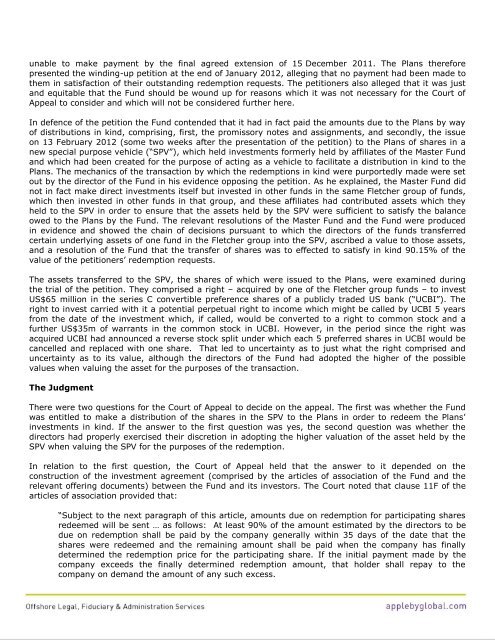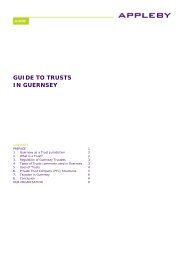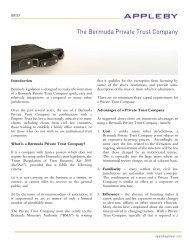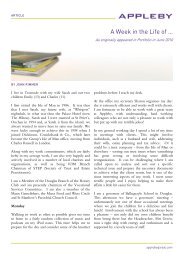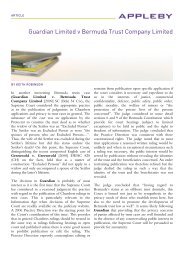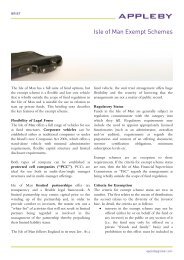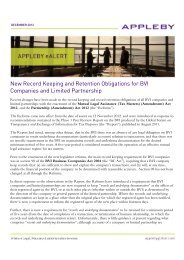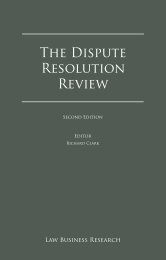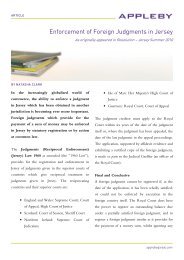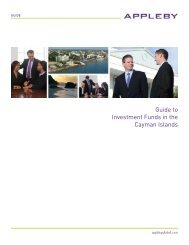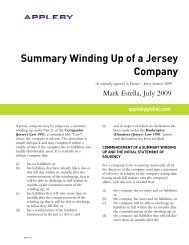FIA Leveraged Fund: The Cayman Court Takes a Strict ... - Appleby
FIA Leveraged Fund: The Cayman Court Takes a Strict ... - Appleby
FIA Leveraged Fund: The Cayman Court Takes a Strict ... - Appleby
You also want an ePaper? Increase the reach of your titles
YUMPU automatically turns print PDFs into web optimized ePapers that Google loves.
unable to make payment by the final agreed extension of 15 December 2011. <strong>The</strong> Plans thereforepresented the winding-up petition at the end of January 2012, alleging that no payment had been made tothem in satisfaction of their outstanding redemption requests. <strong>The</strong> petitioners also alleged that it was justand equitable that the <strong>Fund</strong> should be wound up for reasons which it was not necessary for the <strong>Court</strong> ofAppeal to consider and which will not be considered further here.In defence of the petition the <strong>Fund</strong> contended that it had in fact paid the amounts due to the Plans by wayof distributions in kind, comprising, first, the promissory notes and assignments, and secondly, the issueon 13 February 2012 (some two weeks after the presentation of the petition) to the Plans of shares in anew special purpose vehicle (“SPV”), which held investments formerly held by affiliates of the Master <strong>Fund</strong>and which had been created for the purpose of acting as a vehicle to facilitate a distribution in kind to thePlans. <strong>The</strong> mechanics of the transaction by which the redemptions in kind were purportedly made were setout by the director of the <strong>Fund</strong> in his evidence opposing the petition. As he explained, the Master <strong>Fund</strong> didnot in fact make direct investments itself but invested in other funds in the same Fletcher group of funds,which then invested in other funds in that group, and these affiliates had contributed assets which theyheld to the SPV in order to ensure that the assets held by the SPV were sufficient to satisfy the balanceowed to the Plans by the <strong>Fund</strong>. <strong>The</strong> relevant resolutions of the Master <strong>Fund</strong> and the <strong>Fund</strong> were producedin evidence and showed the chain of decisions pursuant to which the directors of the funds transferredcertain underlying assets of one fund in the Fletcher group into the SPV, ascribed a value to those assets,and a resolution of the <strong>Fund</strong> that the transfer of shares was to effected to satisfy in kind 90.15% of thevalue of the petitioners’ redemption requests.<strong>The</strong> assets transferred to the SPV, the shares of which were issued to the Plans, were examined duringthe trial of the petition. <strong>The</strong>y comprised a right – acquired by one of the Fletcher group funds – to investUS$65 million in the series C convertible preference shares of a publicly traded US bank (“UCBI”). <strong>The</strong>right to invest carried with it a potential perpetual right to income which might be called by UCBI 5 yearsfrom the date of the investment which, if called, would be converted to a right to common stock and afurther US$35m of warrants in the common stock in UCBI. However, in the period since the right wasacquired UCBI had announced a reverse stock split under which each 5 preferred shares in UCBI would becancelled and replaced with one share. That led to uncertainty as to just what the right comprised anduncertainty as to its value, although the directors of the <strong>Fund</strong> had adopted the higher of the possiblevalues when valuing the asset for the purposes of the transaction.<strong>The</strong> Judgment<strong>The</strong>re were two questions for the <strong>Court</strong> of Appeal to decide on the appeal. <strong>The</strong> first was whether the <strong>Fund</strong>was entitled to make a distribution of the shares in the SPV to the Plans in order to redeem the Plans’investments in kind. If the answer to the first question was yes, the second question was whether thedirectors had properly exercised their discretion in adopting the higher valuation of the asset held by theSPV when valuing the SPV for the purposes of the redemption.In relation to the first question, the <strong>Court</strong> of Appeal held that the answer to it depended on theconstruction of the investment agreement (comprised by the articles of association of the <strong>Fund</strong> and therelevant offering documents) between the <strong>Fund</strong> and its investors. <strong>The</strong> <strong>Court</strong> noted that clause 11F of thearticles of association provided that:“Subject to the next paragraph of this article, amounts due on redemption for participating sharesredeemed will be sent … as follows: At least 90% of the amount estimated by the directors to bedue on redemption shall be paid by the company generally within 35 days of the date that theshares were redeemed and the remaining amount shall be paid when the company has finallydetermined the redemption price for the participating share. If the initial payment made by thecompany exceeds the finally determined redemption amount, that holder shall repay to thecompany on demand the amount of any such excess.


